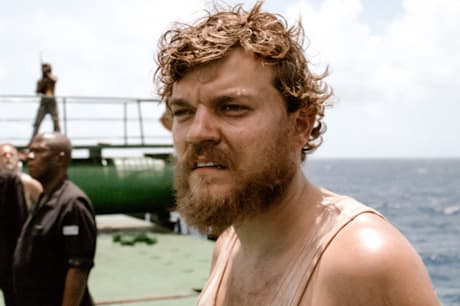As is the standard for global cinema, the corporate ideology, and resultant insinuation of psychotic behaviour, is an easy target for vilification and criticism. Perceived as smug, desiccated and passionless, their cutthroat perspective on financial success over the sanctity of human life and well being is taken to a literal level in Tobias Lindholm's gritty but straightforward drama, A Hijacking.
The film opens with a successful corporate takeover, where Peter Ludvigsen (Søren Malling), the CEO of a large shipping company, drives down the sale price of the other company by several million. Preening like a peacock, his inflated ego leads to a bizarre decision when one of his shipping vessels is hijacked by Somali pirates that demand a ransom for the lives of his employees.
Despite hiring a professional negotiator (Gary Skjoldmose Porter) to aid in resolving this issue without any bloodshed, Peter decides to handle the negotiations himself, inserting his cavalier corporate attitude into a life and death struggle.
Using a realist, documentary style, the majority of the film unfolds on the ship, where Mikkel (Johan Philip Asbæk), the cook, attempts to survive and negotiate with his captors while living in his filth, pissing and defecating in the corner of the same room where he and his shipmates sleep.
Since the negotiations drag on for weeks, an increasing number of flies swirl around the fetid living quarters, heightening the reality of the situation. Mikkel even manages to develop a comfort zone with his captors, which is routinely challenged when they threaten his life and force him to slaughter a small goat (a scene depicted quite vividly, showing a lack of maturity on the part of Lindholm).
While this attention to detail and increasing desperation are impressively rendered and depicted with an appropriate sense of horror, there's an overall sense that the story is going nowhere. We know that the captors will be either saved, murdered or wind up in a nasty fight to the death, but other than this, the trajectory is limited the obvious grotesquery of living conditions and critique of pampered CEOs.
Perhaps this is why Lindholm resorts to sensationalist tactics, such as showing a close-up of an animal slowly bleeding to death, wheezing for breath. It's as though his ego is as inflated as the subject of his criticism, since he seems to think that his "art" is justification for the death of a living creature.
(Nordisk)The film opens with a successful corporate takeover, where Peter Ludvigsen (Søren Malling), the CEO of a large shipping company, drives down the sale price of the other company by several million. Preening like a peacock, his inflated ego leads to a bizarre decision when one of his shipping vessels is hijacked by Somali pirates that demand a ransom for the lives of his employees.
Despite hiring a professional negotiator (Gary Skjoldmose Porter) to aid in resolving this issue without any bloodshed, Peter decides to handle the negotiations himself, inserting his cavalier corporate attitude into a life and death struggle.
Using a realist, documentary style, the majority of the film unfolds on the ship, where Mikkel (Johan Philip Asbæk), the cook, attempts to survive and negotiate with his captors while living in his filth, pissing and defecating in the corner of the same room where he and his shipmates sleep.
Since the negotiations drag on for weeks, an increasing number of flies swirl around the fetid living quarters, heightening the reality of the situation. Mikkel even manages to develop a comfort zone with his captors, which is routinely challenged when they threaten his life and force him to slaughter a small goat (a scene depicted quite vividly, showing a lack of maturity on the part of Lindholm).
While this attention to detail and increasing desperation are impressively rendered and depicted with an appropriate sense of horror, there's an overall sense that the story is going nowhere. We know that the captors will be either saved, murdered or wind up in a nasty fight to the death, but other than this, the trajectory is limited the obvious grotesquery of living conditions and critique of pampered CEOs.
Perhaps this is why Lindholm resorts to sensationalist tactics, such as showing a close-up of an animal slowly bleeding to death, wheezing for breath. It's as though his ego is as inflated as the subject of his criticism, since he seems to think that his "art" is justification for the death of a living creature.
